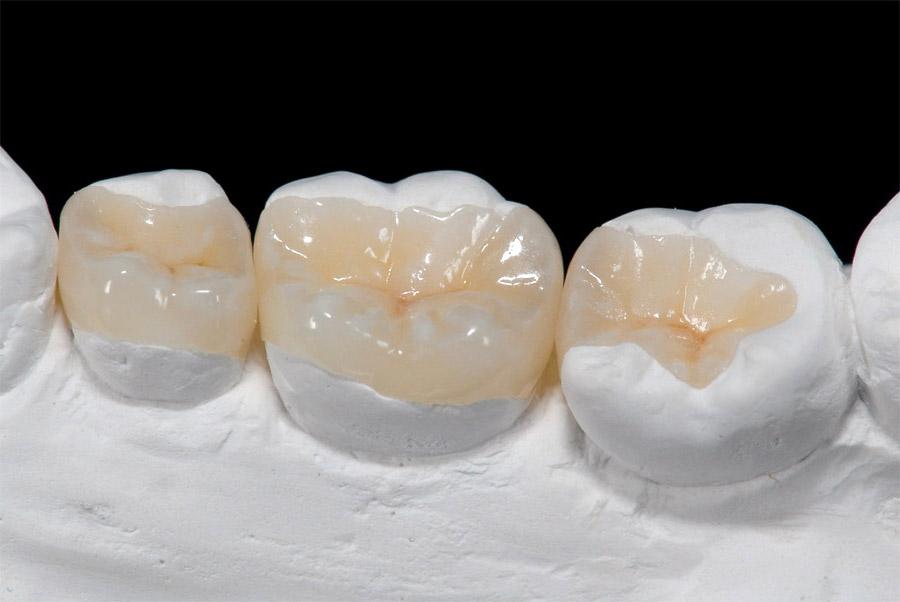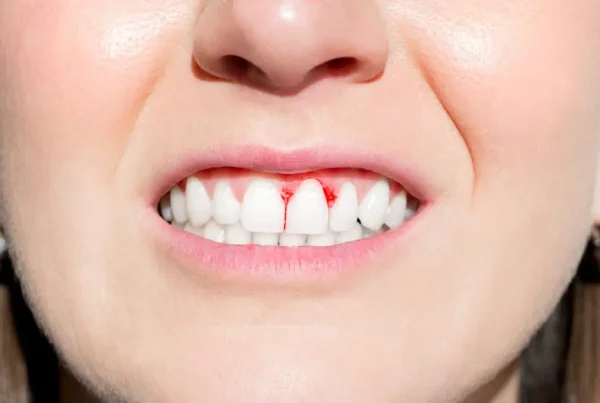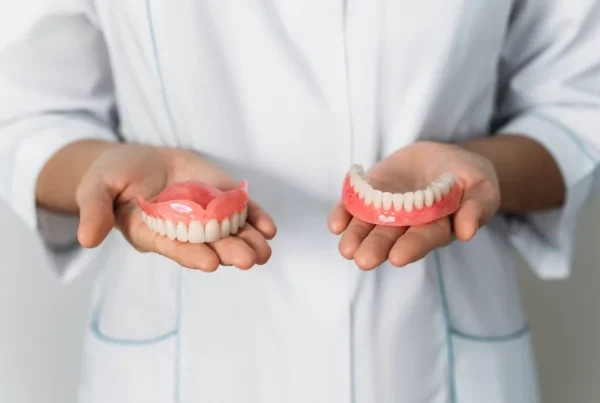
What Are They?
Composite inlay and onlay restorations are aesthetic filling techniques used to repair decayed, broken, or damaged teeth. These techniques aim to restore the tooth’s function and aesthetics by reconstructing its lost or damaged portions.
When Are They Done and Preferred?
Composite inlays and onlays are preferred options for treating various dental problems. If there are medium-sized cavities in the teeth, composite inlays and onlays can be used to treat these cavities. They are preferred when adequate restoration cannot be achieved with traditional filling materials.
If teeth are fractured or damaged, composite inlays and onlays can be used to restore their natural structure. In this case, aesthetic and functional restoration is essential in addition to treating the decayed part of the tooth.
Composite inlays and onlays can also be preferred for correcting aesthetic issues in teeth. Aesthetic concerns are especially taken into account in the treatment of cavities or stains in the anterior teeth.
If preserving the tooth’s natural structure is essential, composite inlays and onlays are less invasive than other restoration options. Therefore, they can be preferred for long-term health by preserving the solid tissue of the tooth.
A dentist recommends composite inlays and onlays based on the specific condition of the patient. The tooth’s condition, the cavity’s size, the tooth’s position, and the patient’s aesthetic preferences are taken into account to create a treatment plan. Therefore, it is essential to consult a dentist before deciding when composite inlays and onlays should be done.
Advantages of Composite Inlay-Onlay Restorations
Composite inlay and onlay restorations are preferred due to various advantages. Here are some significant benefits offered by these restoration techniques:
• Natural Appearance: Composite inlays and onlays can be custom-made to match the tooth color. This allows for the preservation of the natural appearance of the treated tooth and the achievement of aesthetically satisfying results. They prevent the fillings in the teeth from being noticeable.
• Protective Structure: Composite inlays and onlays are an ideal option for preserving the tooth’s natural structure. By protecting the solid tissue of the tooth, they repair the damaged area without the need for more aggressive treatment methods and enhance the tooth’s durability.
• Less Invasive: Compared to traditional fillings, the application of composite inlays and onlays is less invasive. Less removal of the tooth’s natural tissue is required, which ensures more preservation of the tooth’s structure.
• Compatible and Durable: Composite materials have a structure similar to the tooth’s natural tissue, making them durable. Therefore, they can reliably withstand chewing and other daily activities.
• Quick Application: The application of composite inlays and onlays can typically be completed in a single visit. Dentists can manage the treatment process quickly and effectively to save patients time.
• Aesthetic Corrections: Composite materials can quickly correct the shape and color of teeth. Therefore, they are preferred for aesthetic purposes and help improve the patient’s smile.
They are ideal for achieving aesthetic results, preserving tooth structure, and providing durable treatment.
How Long Do Composite Inlays-Onlays Last?
Composite inlays and onlays can be long-lasting when applied correctly. However, several factors can affect the lifespan of these restorations. The lifespan of composite inlays and onlays depends on good oral hygiene habits. Regular brushing, flossing, and periodic dental check-ups can increase the durability of restorations.
The tooth’s location where composite inlays and onlays are placed is also important. Notably, high chewing forces on posterior teeth (premolars and molars) can cause the restorations to wear out more quickly. Chewing on excessively hard or sticky foods with composite inlays and onlays in the teeth can shorten the lifespan of the restorations.
For individuals with teeth-grinding habits, the lifespan of composite inlays and onlays may be shortened. In this case, using night guards worn during sleep or considering treatments to reduce teeth-grinding habits may be recommended.
Generally, the lifespan of composite inlays and onlays ranges from 5 to 10 years. However, factors such as the patient’s dental hygiene habits, tooth structure, oral health, and daily habits affect the lifespan of restorations. Regular check-ups and maintenance performed by a dentist can ensure the long-term durability of composite inlays and onlays.
Inlay-Onlay Treatment Steps
Composite inlay and onlay treatments require a carefully planned process that is completed in several steps. The first step is for the dentist to assess the patient’s condition and determine the treatment plan. The dentist evaluates the extent of the damage and the suitability for treatment.
Measurements of the damaged tooth are necessary for preparing a composite inlay or onlay in the laboratory. The dentist measures the tooth’s size and shape and forwards this information to the laboratory.
While the inlay or onlay is being prepared in the laboratory, the dentist may apply a temporary restoration to the damaged tooth. This temporary restoration preserves the tooth and provides an aesthetic appearance. When treatment begins, the damaged tooth must be prepared. The dentist cleans and shapes the damaged area appropriately. If necessary, old fillings or decayed tissues are removed.
The dentist places the composite inlay or onlay prepared in the laboratory on the damaged tooth. An inlay covers the cavity areas of the tooth, while an onlay also covers the top part of the tooth. During application, the fit of the inlay or onlay is checked, and it is bonded to the tooth.
Coloring and polishing processes are performed to ensure that the inlay or onlay matches the natural tooth color. This step helps achieve aesthetic results. After the placement of the inlay or onlay, the dentist checks the suitability and function of the restoration. If necessary, minor adjustments are made, and final checks are completed.
Inlay and onlay treatments require a meticulous process that requires careful planning and implementation. Good communication between the dentist and the patient is essential for successful treatment outcomes. Regular dental care and check-ups can provide long-lasting restoration with inlays and onlays.
Differences Between Inlay and Onlay
Composite inlay and onlay restorations are similar restorative techniques used to treat various dental problems, but there are significant differences between them.
Inlay
An inlay is used in the restoration of the concave areas on the chewing surface of the tooth. It is generally used to treat damaged or decayed portions of the tooth. The dentist takes measurements for the inlay and sends them to the laboratory. The specially prepared inlay in the laboratory is placed in the decayed or damaged areas of the tooth. The inlay covers the decayed area of the tooth, reinforcing the tooth’s structure and restoring its natural function.
Onlay
An onlay has a wider restoration structure that covers both the chewing surface and the top part of the tooth. It is used to cover a large portion of the tooth or restore the damaged chewing surface as well as the top part of the tooth.
Like the inlay, the onlay also requires measurement and laboratory processing. The onlay prepared by the dentist is placed in the decayed or damaged areas of the tooth. By restoring both the chewing surface and the top part of the tooth, the onlay preserves the solid structure of the tooth and provides an aesthetic appearance.
Inlays and onlays are effective restorative options for repairing damaged areas of teeth and restoring their natural function. However, a dentist should make the choice of treatment, as treatment requirements may vary for each patient.
What to Do After Treatment?
After composite inlay and onlay treatment, it is necessary to follow specific steps to maintain proper care habits and ensure the longevity of the restoration. Some important points to consider after treatment include:
• Regular Dental Hygiene: Brush your teeth every day, especially before bed, with fluoride toothpaste and a soft-bristled toothbrush. You can also clean between your teeth using dental floss or interdental brushes.
• Healthy Eating Habits: You can develop a balanced and nutritious eating habit. You may consider avoiding sugary and acidic foods and beverages. Also, remember that hard and sticky foods can damage your restoration.
• Dental Check-ups: Regular check-ups are crucial for monitoring the condition of the procedure and detecting possible problems early. Therefore, it is recommended to attend check-ups according to the schedule recommended by your dentist.
• Taking Precautions in Case of Teeth Grinding (Bruxism): If you have a teeth grinding habit, you can talk to your dentist and consider using a protective appliance or evaluating other treatment options to reduce teeth grinding habits.
• Protecting Your Mouth: To protect your oral health, you should avoid smoking and consuming alcohol. If you cannot quit completely, you can consider reducing it. Also, do not forget to use a suitable mouthguard to protect your mouth while exercising.
Following these steps after treatment can increase the long-term success of composite inlay and onlay restorations and help you maintain your dental health. Remember that regular care and check-ups are essential measures for a healthy smile.





